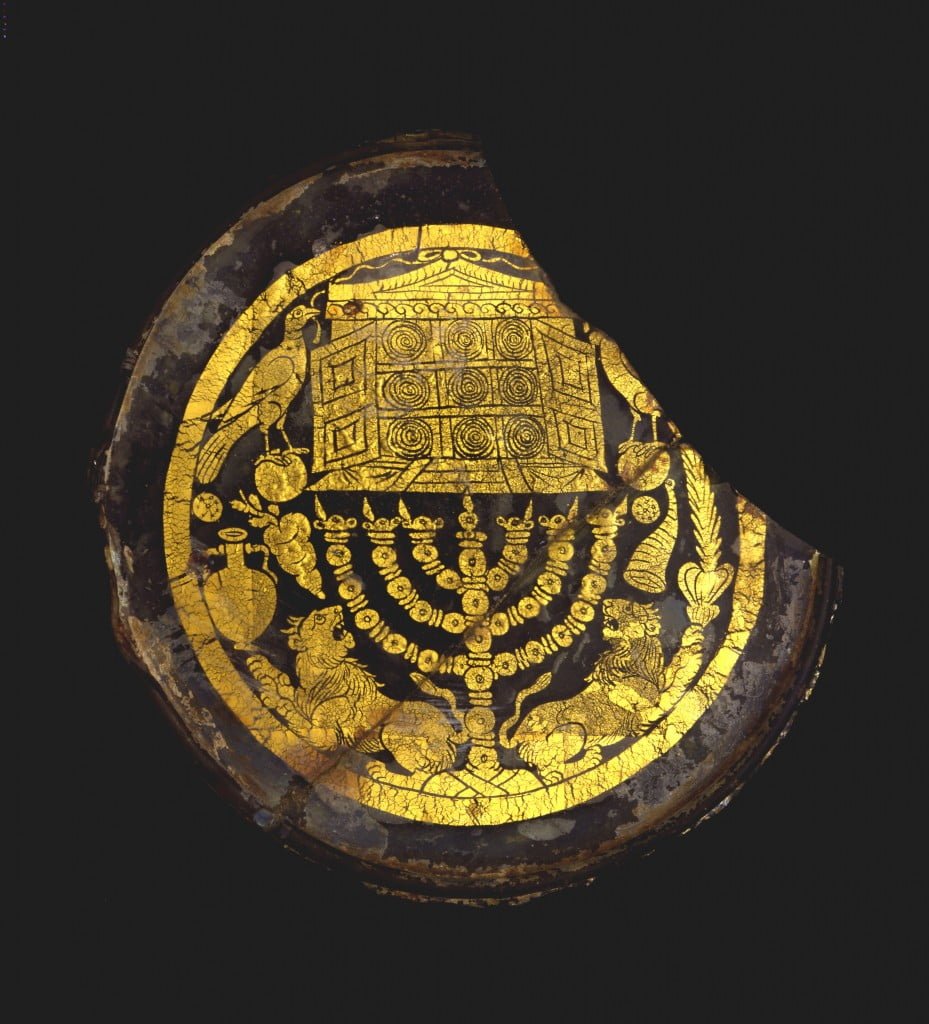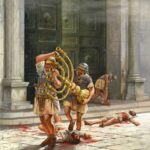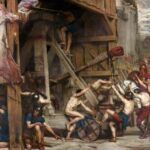Golden glass – this is the name used to describe the parts of the dishes (bowls, plates, cups, etc.), most often they were bottoms or their walls, and they were small works of art in themselves, assuming an oval or round shape. The technique of making them was based on placing gold leaves decorated with a pattern, often with an inscription, between two panes of glass, which later became part of the dishes when the edges were heated.
This technique was very popular in the late Empire period between the 3rd and 5th centuries CE. Unfortunately, no such vessel has survived in its entirety to this day, so it is difficult to determine what they were and what they were used for. It is suggested that they were used during feasts, e.g. for making toasts (many of these glasses contain inscriptions encouraging drinking; drinking=life), they could also be a gift on the occasion of Christmas, birth, baptism or New Year – as evidenced by numerous dedications.
About 500 pieces of this type of artifact have survived to this day. The bottoms that survived were cut out of the dishes, sometimes the vessel probably broke, and the thick decorated bottom remained, becoming a valuable souvenir that it was decided to use. They were placed on the walls of the catacombs and embedded in the limestone base. Among the numerous funerary niches, it would be difficult to discern who and where was buried; such golden glasses, along with other objects, were a signpost in finding the tomb of a loved one.
The subject of decorations was varied. Most are portraits, most often married couples, often signed. The second, large group are performances related to the Christian religion. These are figures of saints, Jesus, biblical scenes. A very small part – 13 or 14 pieces – is related to the Jewish religion and depicts the symbols of their worship.
For the Jewish diaspora who came to Rome in the first century CE, after the destruction of the Temple of Jerusalem, these were very valuable artifacts, because they contained the oldest representations of religious symbols from outside of Jerusalem. They were found mainly in the Roman catacombs, but also in today’s Cologne or Alexandria, where Jews constituted a larger population. The nature of the ornaments of these golden glasses is different, they do not represent portraits, but are strictly related to the Judaic culture. Sometimes, however, it is difficult to judge whether it was made by the Jewish community or whether it was a product of early Christians. Next to scenes from the Bible (Daniel in the lion’s cave, or Jonah in the mouth of a whale) we find: a characteristic menorah, a seven-branched candlestick, Aron ha kodesh – a cabinet where the Torah, the Temple of Jerusalem were kept, as well as animal motifs, e.g. birds, lions, fish, rams horns, palm branches or citron fruit. The Jews used the vessels, which were part of these bottoms, for the same purposes as the Romans. Here, too, there are numerous inscriptions on a similar theme, encouraging to feast, which testifies to the partial assimilation and adoption by the Jews of the habits of the inhabitants of Rome.
After many centuries, golden glasses became the object of interest again. They began to be excavated on a larger scale from tombs and catacombs in the 17th and 18th centuries, often as a result of robbery, from where they ended up in private collections and collections at the courts of many European countries. In this way, at the beginning of the 19th century, three of them were obtained by Countess Działyńska for her ordination in Gołuchów – they increased the already large collection of works straight from the antiquity or the Middle Ages.
The first of these glasses is divided into two sections, the upper part shows the Aron Kodesh, where six Torah scrolls are placed, on the sides there are two lions of Judah. In the lower part there are two menorahs between which there are branches of myrtle and willow (lulav) etrog fruit, two amphoras and the ram’s horn shofar – these elements are related to the Jewish Feast of Tabernacles. The whole picture is surrounded by a square frame decorated with red and blue decorations. At the top there is the Greek inscription: PIE ZESIS ELARES, meaning Live and drink Elares.
The second glass contains a very similar symbolism, with the difference being the chest, that the cabinet with nine scrolls is guarded by two birds on the flanks; the whole is surrounded by a round frame.
In the face of the impending war in 1939, these three golden glasses, as well as the rest of the valuable collection of Działyński’s works of art, were taken from Gołuchów to Warsaw, where they were found and confiscated by the Nazis in 1941. In 1944 the collection was taken to the Fischhorn Castle in Zell am See in Austria. After the war, the collection was stolen by the local population and traders.
Years later, the heirs of the Działyński family made every effort to find the accumulated property, but the glasses were lost. It was only in the 1960s that they were acquired for the emerging Israel Museum. In 2008, as a result of negotiations, the Museum decided to return them to their rightful owners, but two of them will still be presented at the exhibition in Jerusalem; one was given to the descendants of the Działyński family.
- Roman golden glass
- Roman golden glass









